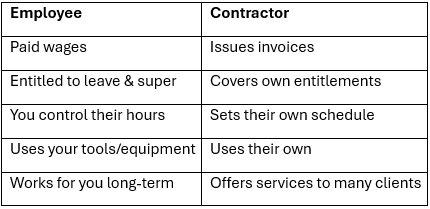Article
Can I Pay My Nanny via an ABN?

Using an ABN to Pay Your Nanny
If you're hiring a nanny or in-home carer in Australia, you might be wondering:
"Can I just pay them using an ABN and treat them as a contractor?"
It’s a common question, but in most cases, the answer is no. While it might seem easier to treat your nanny as a contractor, the Fair Work Ombudsman and the ATO are very clear: most nannies should be classified as employees.
In this guide, we’ll break down the difference between a contractor and an employee, why it matters, the risks of getting it wrong, and how Pay The Nanny can help you stay compliant and make it all easy.
Why This Matters
Whether you treat your nanny as an employee or a contractor impacts how they’re paid, the entitlements they receive, and what you’re legally responsible for as their employer.
If you get it wrong, even by accident, you could be liable for unpaid superannuation, tax, annual leave, and more. The ATO may impose fines, backdated obligations, and interest charges if they believe you’ve engaged in sham contracting.
Think Your Nanny Is a Contractor? Ask Yourself:
If your nanny:
- Works in your home
- Works to a regular schedule you set
- Uses your equipment (like prams, car seats, etc.)
- Doesn't advertise their services regularly to the public
- Can’t send someone else in their place
Then they’re probably an employee, not a contractor. That means they should be paid as an employee and not via their ABN.
What’s the Legal Difference?
The Fair Work Ombudsman and ATO both provide clear guidelines to distinguish employees from independent contractors.
Here’s a quick summary:

See the ATO’s employee vs contractor guidance here
6 Questions to Help You Decide
If you’re still unsure, ask yourself these:
- Do you decide when and how they work?
- Do they mostly work for your family?
- Are they using your tools and resources?
- Do they get paid hourly or regularly (not per project)?
- Is the arrangement ongoing?
- Are you the one managing their tasks?
If you answered “yes” to most of these, you likely have an employee.
What If I Get It Wrong?
If you treat a nanny as a contractor when they’re actually an employee, you could be on the hook for:
- Unpaid superannuation
- Back pay for leave entitlements
- Penalties for sham contracting
- Legal action from the nanny
- ATO audits and fines
Even with an ABN, a nanny doesn’t automatically become a contractor. The substance of the working relationship matters more than the paperwork.
What You Must Do as an Employer
Once you establish that your nanny is an employee, here’s what you need to do:
1) Set Up a Written Employment Contract
Required under the Fair Work Act. We can provide templates that meet Australian employment standards. If you need help with this, get in touch with the team at Pay The Nanny.
2) Pay Superannuation
You must pay super for any nanny who is working over 30 hours a week.
3) Withhold PAYG Tax
You’re required to register as an employer and deduct PAYG tax. You can do this yourself or use a payroll provider like us.
4) Provide Entitlements
Full-time and part-time nannies are entitled to annual leave, sick leave, and public holidays. If your nanny is employee
5) Provide Payslips
Payslips must be issued every pay period and include all relevant details.
6) Confirm Their Right to Work
You must confirm your nanny has the legal right to work in Australia (e.g. via visa checks if applicable).
Common Mistakes Families Make
- Paying cash without records
- Letting the nanny invoice to avoid tax
- Calling it “casual” when the work is regular
- Not paying super or leave
These might feel simpler, but they often result in backpay claims, fines, and stress down the track.
Why Compliance Is a Win-Win
By getting it right:
- Your nanny gets the job security and entitlements they’re owed.
- You avoid financial and legal risk.
- You show that you respect the role they play in your child’s life.
- Your nanny’s financial wellbeing is improved as they have proof of payslips and regular earnings (which helps with getting a mortgage etc)
It’s also the professional and fair thing to do, which helps build a great working relationship.
How Pay The Nanny Can Help
We make it easy for Aussie families to employ their nanny properly - without the paperwork headaches.
With Pay The Nanny, we handle:
- Payment and filing with the ATO
- Payment and filing for superannuation
- Tax and super calculations
- Digital timesheets and payslips
- Leave entitlements
- Employment contract templates
- Weekly, fortnightly or monthly payroll runs
- End-of-year summaries
- Generalised HR support
We’re a dedicated nanny payroll service built for busy families who want to do the right thing - without becoming tax experts.
Need Help?
If you're unsure about how to pay your nanny, or whether you can legally use an ABN, don’t risk guessing. Get it right from the outset and you’ll make your life a lot easier down the track!
- Visit www.paythenanny.com.au
- Or reach out to our friendly team — we’re happy to help.

Nanny Pay Rates for 2025

Top 7 Tips to Keep Your Nanny Happy

Simplifying Nanny Payroll: 5 Easy Steps for Stress-Free Payments

2025 Guide to Employment Contracts for Nannies in Australia
